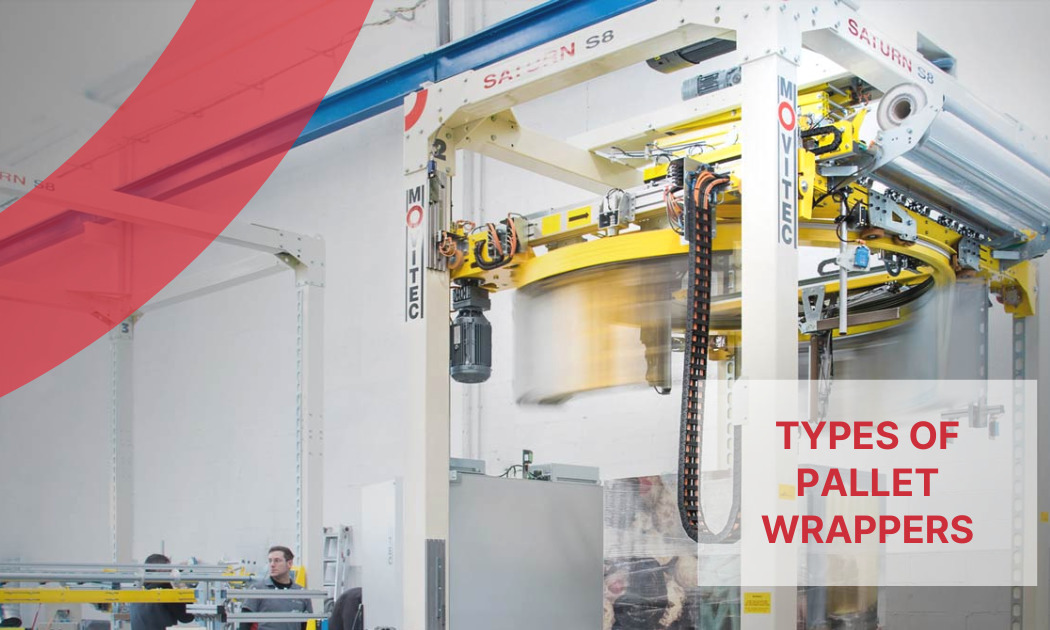Pallet stretch wrappers are machines that cover, thereby wrapping, the load on a pallet. They do so with a transparent film, which can be stretched, and they can be used for any type of pallet, regardless of its dimensions or weight. In addition, they are automatic, which avoids having to wrap the loads by hand so that they are secured and protected. It is, therefore, a very useful machine for all types of companies dedicated to the logistics and distribution of all types of products.
But they are not all the same. There are different types, as you will see below. Pallet stretch wrappers can be classified into two different types. Then, each of these types, depending on their mode of operation, can be subdivided into several further categories.
Pallet stretch wrappers: main types
As mentioned above, pallet stretch wrappers can be one of two types. These types categorize them according to their level of automation in operation. These are:
1 – Semi-automatic wrappers
Pallet stretch wrappers of this type require an operator to place the transparent film with which the pallet loads are wrapped. Of course, once the machine and film are ready and positioned to start the process, there is no need for the operator to do anything else. It will be the machine that wraps everything automatically.
Of course, the operator also has to establish the level of tension that the film will have. If the cargo is light or fragile, it is not advisable to apply a very tight wrapping of film over the top of it. It could lead to load breakage or damage to the load. It is better to wrap these loads with less pressure, and increased pressure for firm and resistant loads.
Then, when the process is finished, the operator has to remove the pallet from the platform, now completely wrapped. The number of turns the machine has to make for the pallet to be wrapped is chosen by the operator, depending on several variables. Among them, the weight of the load. It also offers the opportunity to choose where on the pallet to apply a reinforcement to the fastening it will have. Within these there are three categories:
– Pallet wrappers with rotating platform: this machine has a platform, on which the operator has to place the pallet with the load. The transparent film must then be placed in position, and care must be taken to ensure that the end is attached to the load and the pallet. Once this is done, simply press the button to start the pallet wrapping process. These machines are between two and four meters high. Therefore, they are capable of wrapping pallets up to three and a half meters high, on a regular basis.
– Rotary pallet wrapping robots: can be used to wrap loads of any shape and size, and are designed to prevent them from being wrapped in such a way that they can move. Unlike other stretch wrappers, in which the pallets rotate until they are wrapped, it is the stretch wrapper that rotates around the load as it wraps it. They can wrap loads up to a maximum height of two and a half meters. However, they are not recommended for light loads, because when moving, the robot could move the load.
– Rotary arm stretch wrappers: used for heavy loads and pallets. These consist of a main structure, from which a fixed arm comes out, and a mobile one. The main arm is anchored to the ceiling of the space where it is installed. The mobile arm rotates around the pallet to be wrapped.
2 – Automatic wrapping machines
Unlike semi-automatic pallet stretch wrappers, automatic pallet stretch wrappers do not require an operator to adjust the stretch film used to wrap the pallet load. They will do it all by themselves, and all that needs to be done is to press one or several buttons for them to do the wrapping. As with the previous type of stretch wrappers, there are also three categories of automatic wrappers:
– Automatic stretch wrappers with rotating arm: this type of stretch wrapper is usually installed at the end of the production line in a factory. However, the type of production lines on which it is installed usually have a high level of task automation. That being said, it can also be used independently, but in these cases it has several auxiliary tools, such as conveyors to pick up the pallet and place it at the point where the machine will wrap its load. Others are also designed to remove the pallet once it is wrapped. They are used in chains and plants with a medium to high production level, are compatible with unstable loads and of various sizes and dimensions.
– Automatic rotary ring stretch wrappers this is a type of machine that has a tubular main structure, generally made of steel. This structure stands out for its solidity, and also incorporates four telescopic legs, with reinforcements at the feet and at the points where it supports a maximum level of stress.
– Automatic orbital stretch wrappers: this is a type of stretch wrapper designed and manufactured to be integrated into a pallet and load wrapping line equipped with pallet conveyors. It works as follows: the loads to be wrapped, with their pallets, enter the system. To move them forward, they are pushed by a system consisting of several drive belts equipped with motors. These drive the pallets to a circular zone that turns. Then, as it rotates with the pallet and its load, the machine begins to wrap the pallet load as they go around.
These are the main types of pallet wrappers you have to choose from if you want to install one or more for your company. Once you have decided, install the ones that suit you best to prepare your pallets for the transport of goods!


